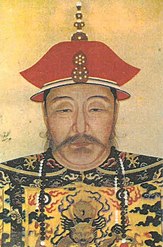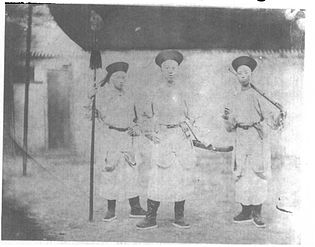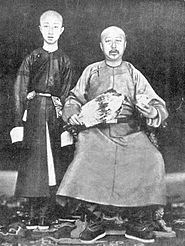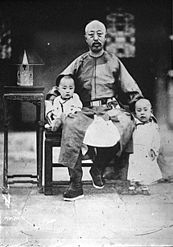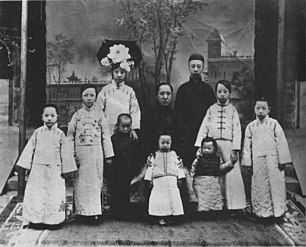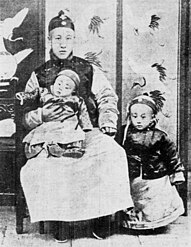Aisin Gioro
Aisin Gioro ( Manchurian ᠠᡳᠰᡳᠨ
ᡤᡳᠣᡵᠣ, Pronunciation [ ai.ɕin.kiɔ.rɔ ]; Chinese 愛新覺羅 , Pinyin Àixīn Juéluó ) is the family name of the rulers of the later Jin Dynasty and then the imperial clan of the Manchu emperors of the Qing Dynasty . The house of the Aisin Gioro ruled China from 1644 until the Xinhai Revolution of 1911/12. Aisin has the meaning of gold in Manchurian and "gioro" designates the ancestral seat (Chinese 籍貫 - jíguàn, 祖籍 - zǔjí, 老家 - lǎojiā) in today's Yilan in Heilongjiang . According to the Manchu custom, families are named after their hala (哈拉) and denoted more precisely by the mukūn (穆昆). The hala is the superordinate family / clan name and the mukūn is a more subdivided classification that mostly refers to individual small families. In the present case, aisin is the “mukūn” and gioro is the “hala”. Other groups of the Gioro clan are Irgen Gioro , Susu Gioro (舒舒 覺 羅) and Sirin Gioro (西林 覺 羅).
The Jin of the Jurchen was already known as aisin gurun and the Qing dynasty was originally called amaga aisin gurun ( ![]() ) or "Later Jin Dynasty". After the fall of the Qing Dynasty in 1911, members of the family changed their name to Jin ( 金 ) due to the synonym for "Aisin". Puyi's younger brother, for example, changed his name from Aisin Gioro Puren ( 愛新覺羅 溥 任 ) to Jin Youzhi ( 金 友 之 ) and his children took Jin as a family name.
) or "Later Jin Dynasty". After the fall of the Qing Dynasty in 1911, members of the family changed their name to Jin ( 金 ) due to the synonym for "Aisin". Puyi's younger brother, for example, changed his name from Aisin Gioro Puren ( 愛新覺羅 溥 任 ) to Jin Youzhi ( 金 友 之 ) and his children took Jin as a family name.
Generation names of the family
Before the founding of the Qing Dynasty, the naming of the children of the Aisin Gioro was not subject to any fixed rules. The Manchu did not use generational names before immigrating to the area of China, and before the rule of Shunzhi , children of the imperial family were given only Manchu names, such as Dorgon .
After the conquest of China, Manchu Han Chinese customs took over . It was not until the reign of Emperor Kangxi that all of the emperor's sons were given generational names. Originally the three syllables Cheng (承), Bao (und) and Chang (長) were used before Yin (胤) was used for a decade . The generation prefixes of Yongzheng's sons were Fu (福) and Hong (弘). Qianlong ordered that all future male descendants should be given a generation name taken from a "generation poem". He himself wrote the first line of this poem: Yong Mian Yi Zai (永 綿 奕 載). In addition, the names of direct descendants were often chosen so that a common radical appeared in the last syllable sign. A common radical also appeared in the second syllable of princes who were in line to the throne. Yongzheng once also changed his brother's generation name to keep his own name unique. From the time of Emperor Daoguang , however, such interventions no longer occurred.
Generational syllables
In 1938 Puyi wrote a new "generation poem" from which the twelve characters have been taken that have not yet been assigned to any person.
| sequence | Generational prefix | Radical code | Examples |
|---|---|---|---|
| Yongzheng | Yin (胤; yìn ), Yun (允; yǔn ) | Shi (示; shì ) | Yinzhen , Yunreng , Yunsi , Yinxiang , Yunti |
| Qianlong | Hong (弘; hóng ) | Ri (日; rì ) | Hongli , Hongzhou |
| Jiaqing | Yong (永 / 顒; yǒng ) | Yu (玉; yù ) | Yongyan , Yongqi |
| Daoguang | Mian (綿; mián ), Min (旻; mǐn ) | Xin (心; xīn ) | Minning , Mianyu |
| Xianfeng | Yi (奕; yì ) | Yan (言; yán ) | Yizhu , Yicong , Yixin , Yixuan , Yikuang |
| Tongzhi / Guangxu | Zai (載; zài ) | Shui (水; shuǐ ) | Zaichun , Zaitian , Zaifeng , Zaitao , Zaiyi , Zaixun |
| Xuantong | Pu (溥; pǔ ) | Ren (人; rén ) | Puyi , Pujie , Puren , Puru |
| N / A | Yu (毓; yù ) | Shan (山; shān ) | Yuzhan , Yuyan |
| Heng (恆; héng ) | Jin (金; jīn ) | Hengxu | |
| Qi (啟; qǐ ) | Qicong , Qigong | ||
| Dao (焘; dào ) | |||
| Kai (闓; kǎi ) | |||
| Zeng (增; zēng ) | |||
| Qi (祺; qí ) | |||
| Jing (敬; jìng ) | |||
| Zhi (志; zhì ) | |||
| Kai (開; kāi ) | |||
| Rui (瑞; ruì ) | |||
| Xi (錫; xī ) | |||
| Ying (英; yīng ) | |||
| Yuan (源; yuán ) | |||
| Sheng (盛; shèng ) | |||
| Zheng (正; zhèng ) | |||
| Zhao (兆; zhào ) | |||
| Mao (懋; mào ) | |||
| Xiang (祥; xiáng ) |
origin
Even if the Aisin Gioro clan likes to trace back to the Jurchen ( Jin dynasty (1125-1234) ), it is not related to the Wanyan dynasty . The Khan Huang Taiji stated explicitly: "We are not descendants of the earlier Jin emperors."
The clan also claimed that Bukūri Yongšon (布 庫里 雍 順) was of a virgin birth . Legend has it that three heavenly girls, Enggulen (恩古倫), Jenggulen (正 古 倫) and Fekulen (佛 庫倫), bathed in Lake Bulhūri Omo on the Changbai Mountains . A magpie dropped a piece of a red fruit next to Fekulen and she ate it. As a result, the girl became pregnant and gave birth to Bukūri Yongšon.
Among their famous ancestors are the Aisin Gioro and Mentemu from the Odoli clan, who served as chief of the Jianzhou Jurchen .
Expansion under Nurhaci and Huang Taiji
Under Nurhaci and his son Huang Taiji , the Aisin Gioro clan gained dominance among the rival Jurchen tribes in the northeast and spread through campaigns of conquest and alliances into Inner Mongolia . Nurhaci created large units that permanently took on both civil and military functions, the so-called " banners ". He replaced the small hunting teams that were used in earlier military campaigns. A banner consisted of smaller units; it comprised about 7,500 warriors (with their households, including the slaves) who were under the command of a chief. Each banner was marked by a colored flag in yellow, white, blue, red, each with or without a border or fringe. Originally there were four, later eight banners. New banners emerged as the Manchu conquered new territories, and ultimately there were eight banners each for Manchu, Mongol and Chinese. In 1648 not even a sixth of the banner men were Manchu. The subjugation of the Ming dynasty was accordingly a multi-ethnic upheaval that was supported by the Manchu nobles as well as by the Han Chinese generals. The Han Chinese were usually organized under the banner of the Green Standard. This banner developed into a kind of imperial paramilitary , which took on special tasks throughout China and on the borders.
Marriage Policy and Alliances
The Qing emperors arranged marriages between Aisin Gioro women and strangers in order to form political marriage alliances. During the conquest, the Manchu rulers motivated Chinese officers to betrayal and change of flag by promising them their daughters, and in other places too, princesses were married to Mongol princes.
A first success was the bribery of General Li Yongfang (李永芳). He later married a daughter of Abatai , a son of Nurhaci . This triggered a wave of defectors. More than 1,000 marriages between Han Chinese and Manchu women were concluded in 1632 on the basis of an offer from Yoto (岳托), a nephew of Emperor Huang Taiji. Huang Taiji was convinced that mixed marriages could prevent ethnic conflicts in the conquered areas and that this would make the Han forget their roots more quickly.
Other famous defectors who were married to Manchu women were the sons of the "Three Feudal Lords" in the south. The sons of Generals Sun Sike (孫 思克), Geng Jimao , Shang Kexi and Wu Sangui were married to Manchu girls and they were given the rank of e'fu (額 駙, princess consort). Geng Zhongming, a Han ban man, received the title of "Prince Jingnan" and his grandchildren Geng Jingzhong, Geng Zhaozhong (耿昭忠) and Geng Juzhong (耿聚忠) married Hooge's daughter, Abatai's granddaughter, and Yolo's daughter. Sun Sike's son, Sun Cheng'en (孫承恩), married Kangxi's fourth daughter, Heshuo Princess Quejing (和 硕 悫 靖 公主).
The daughter of the "Imperial-Duke-who-supported-the-State" (宗室 輔國公, Zōngshì fǔ guó gōng), Aisin Gioro Suyan (蘇 燕), was married to General Nian Gengyao .
genetics
The haplogroup C-M217 (Haplogroup C3c) appears to be a common genetic marker of the Aisin Gioro. However, it can be found among ten different ethnic minorities in northern China.
Personalities
Emperor
Aisin Gioro Family Tree (in English) :
- Nurhaci (1559–1626), founder of the Qing Dynasty
- Huang Taiji (1592–1643), Nurhaci's eighth son
- Fulin (1638–1661), Emperor Shunzhi , Huang Taiji's ninth son
- Xuanye (1654–1722), Emperor Kangxi , Shunzhi's third son
- Yinzhen (1678–1735), Emperor Yongzheng , Kangxi's fourth son
- Hongli (1711–1799), Emperor Qianlong , Yongzheng's fourth son
- Yongyan (1760-1820), Emperor Jiaqing , Qianlong's fifteenth son
- Minning (1782–1850), Emperor Daoguang , Jiaqing's second son
- Yizhu (1831–1861), Emperor Xianfeng , Daoguang's fourth son
- Zaichun (1856–1875), Emperor Tongzhi , Xianfeng's firstborn
- Zaitian (1871–1908), Emperor Guangxu , second son of Yixuan , "adopted" as Tongzhi's brother
- Puyi (1906–1967), Emperor Xuantong, Zaifeng's firstborn, "adopted" as Guangxu's son
Iron-hat princes and their descendants
Nobility ranks (English) According to the tradition of the Qing Dynasty, children do not automatically inherit the titles of their fathers. Yongqi, for example, received the title "Prince Rong of First Rank". His son Mianyi, however, received the title "Prince Rong of second place". Accordingly, the rank decreased with each generation, but overall never further than the rank of "Imperial Duke second class" (feng'en fuguo gong) in the "royal and noble ranks of the Qing". There were twelve princes who were raised to the rank of shi xi wang ti ("iron hat"), which meant that their rank could be inherited without the rank being lowered.
The 12 iron hat lines (铁 帽子 王, tie mao zi wang) are listed below. Some of you have changed names over time, so you have several names listed.
- Prince Li (禮) / Prince Xun / Prince Kang, line of Daišan (1583 - 1648)
- Prince Rui (睿), line of Dorgon (1612--1650)
- Prince Yu (豫), line of Dodo (1614--1649 )
- Prince Zheng / Prince Jian, Line of Jirgalang ( 1599-1655 )
- Prince Su , line of Hooge (1609--1648)
- Prince Zhuang , Prince Chengze, Prince Zhuang, line of Šose ( 1629-1655 )
- Prince Shuncheng , line of Lekdehun ( 1619--1652 )
- Prince Yi (怡) , lineage of Yinxiang ( 1686-1730 )
- Prince Gong , Lineage of Changning (1657-1703) and Yixin (1833-1988)
- Prince Chun (醇) , line of Yixuan (1840-1891 )
- Prince Qing , line of Yonglin ( 1766--1820 )
- Prince Keqin / Prince Cheng / Prince Ping / Prince Yanxi, line of Yoto (1599 - 1639)
Famous family members
- Daišan (1583 - 1648), Nurhaci's second son, participated in the conquest of China
- Jirgalang (1599 - 1655), Nurhaci's nephew, co-regent with Dorgon at the beginning of Shunzhi's reign
- Ajige (1605 - 1651), Nurhaci's 12th son, participated in the conquest of China
- Dorgon (1612-1650), Nurhaci's 14th son, Prince Regent and de facto ruler at the beginning of Shunzhi's reign
- Dodo (1614 - 1649), Nurhaci's 15th son, took part in the conquest of China
- Yinsi ( 1681-1726 ), Kangxi's eighth son, Yinzhen's competitor, later excluded from the clan
- Yinxiang ( 1686-1730 ), Kangxi's thirteenth son, Yinzhen's ally
- Yinti ( 1688-1756 ), Kangxi's fourteenth son, Yinzhen's competitor
- Duanhua ( 1807-1861 ), descendant of Jirgalang , ruler for Tongzhi, deposed by the Xinyou Coup in 1861
- Sushun (1816-1861), Duanhua's brother, regent of Tongzhi, deposed by the Xinyou coup of 1861
- Zaiyuan (1816 - 1861), descendant of Yinxiang, ruler for Tongzhi, deposed by the Xinyou coup of 1861
- Yixin (1833-1898), Daoguang's sixth son, Prince Regent during Tongzhi's reign
- Yikuang (1838-1917), descendant of Yonglin , Prime Minister of the Imperial Cabinet
- Yixuan ( 1840-1891 ), Daoguang's seventh son, father of Guangxu
- Zaiyi (1856-1922), Yicong's son, leader of the Boxer Rebellion
- Zaize ( 1876-1929 ), sixth generation great-grandson of Kangxi, finance minister and salt minister
- Zaizhen ( 1876-1947 ), Yikuang's son, minister
- Zaifeng (1883-1951), Yixuan's son, Puyi's father, Prince Regent during Puyi's reign
- Zaixun ( 1885-1949 ), Yixuan's sixth son, Minister of the Navy
20th century & present
- Pu Xuezhai (溥 雪 齋; Pujin 溥 伒; 1893 - 1966), Guqin musician, painter, grandson of Yicong (Prince Dun)
- Puru ( 1896-1963 ), Taiwanese artist and calligrapher, grandson of Yixin (Prince Gong)
- Jin Guangping (Aisin-Gioro Hengxu; 1899-1966), linguist for Jurchen and Khitan
- Pujie ( 1907-1994 ), Puyi's brother, member of the Political Consultative Conference of the Chinese People , head of the Aisin Gioro clan 1967-1994
- Qigong (1912-2005), artist and calligrapher, descendant of Prince He
- Jin Qicong ( 1918-2004 ), Jin Guangping's son, historian and linguist for Manchu and Jurchen
- Yuyan ( 1918-1997 ), calligrapher, nephew of Puyi
- Jin Youzhi (Puren, 1918-2015 ), Puyi's half-brother, head of the Aisin Gioro clan 1994-2015
- Aisin Gioro Yuhuan ( 1929-2003 ), Sanxian player, painter
- Gu Changzhen (* 1929), Puyi's nephew, member of the Guwalgiya family in the Aisin Gioro clan
- Jin Yuzhang (* 1942), Jin Youzhi's son, governor of Beijing's Chongwen District, head of the Aisin Gioro clan since 2015
- Jin Pucong (* 1956), Taiwanese politician
- Zhao Junzhe (* 1979), soccer player, descendant of Boolungga , the fifth brother of Nurhaci's grandfather Giocangga
- Aisin-Gioro Ulhicun , Jin Qicong's daughter, historian and linguist for Manchu, Jurchen and Khitan
gallery
- Images
Nurhaci on the throne
Yixuan with Li Hongzhang and Shanqing
Yixuan with his sons Zaixun and Zaifeng
Zaifeng with escort & German officers in Qingdao
Zaifeng & his sons, Puyi & Pujie
See also
Individual evidence
-
^ Edward JM Rhoads: Manchus and Han: ethnic relations and political power in late Qing and early republican China, 1861–1928 . University of Washington Press, Seattle / London 2001, ISBN 0-295-98040-0 , pp. 55 : “In the beginning, among the first couple of generations, Manchu men had polysyllabic personal names (eg, Nurhaci) that in their native language may have been meaningful but when transliterated by sound into Chinese characters were gibberish; furthermore, they did not arrange their personal names in generational order, as Han often did. " Mark C. Elliott: The Manchu Way: The Eight Banners and Ethnic Identity in Late Imperial China . Stanford University Press, Stanford (California) 2001, ISBN 0-8047-3606-5 , pp.
243 : “Manchu naming practices also differed when it came to naming the children of the same generation. Chinese practice, at least among elites, typically called for all children of the same lineage and same generation to share the same first character of the given name. All the brothers and cousins (or sisters and cousins) of the same generation would be identified by this character (sometimes called beifen yongzi), which greatly simplified the determination of relationships. " -
^ Mark C. Elliott: The Manchu Way: The Eight Banners and Ethnic Identity in Late Imperial China . Stanford University Press, Stanford (California) 2001, pp. 244 : "Relationships within the line. The Manchus were not so careful about this sort of thing […] The Chinese practice of using the same first character for the given names of children of same generation was initially adopted during the reign of the Kangxi Emperor. The children of Kangxi all sported the same prefix character, yin (written 'in' in Manchu), and every generation afterward was marked by the same initial character (or, in Manchu, the same initial sounds) in the given name. While some Manchu families followed suit, many others did not, or did so inconsistently: for example, the brother of an early-eighteenth-century general, Erentei, was named Torio, while the Xi'an general Cangseli named his son Cangyung, using the same sound, 'cang' ('chang' in Chinese), for his and the following generation. " Edward JM Rhoads: Manchus and Han: ethnic relations and political power in late Qing and early republican China, 1861-1928 . University of Washington Press, Seattle / London 2001, ISBN 0-295-98040-0 , pp.
55 : “With the imperial clan itself taking the lead, Manchus started to shorten their personal names to disyllabic ones (eg, Yinzhen, for the future Yongzheng emperor), to adopt names that were meaningful and felicitous in Chinese, and to assign names on a generational basis. By the time of the Guangxu emperor (r. 1875–1908), all the males of his generation in the imperial clan had the character zai in their personal names, such as Zaitian (the emperor), Zaifeng (1883–1952; his brother and future regent), and Zaizhen (1876–1948; his cousin). By contrast, the previous generation had used the character yi (eg, Yikuang, Yixin, and Yihuan), while the following generation used the character pu (eg, the future Xuantong emperor Puyi [1906–67] and his brother Pujie [1907– 94]). " - ^ Edward JM Rhoads: Manchus and Han: ethnic relations and political power in late Qing and early republican China, 1861–1928 . University of Washington Press, Seattle / London 2001, ISBN 0-295-98040-0 , pp. 56 : "In a further refinement of the generational principle, the second character in the personal name of each person in the direct line of succession contained a radical that distinguished these name from all others of their generation in the imperial clan. Thus, the tian character in 'Zaiyian' and the feng character in 'Zaifeng' shared the 'water' radical; the same as the zhen in 'Zaizhen' (written with the 'hand' radical) did not, because as the son of Yikuang (Prince Qing), Zaizhen was not in the direct line of succession. "
- ↑ 滿洲 源流 考 Qing ding Man Zhou Yuan Liu Kao, 本 朝 者 謂 雖 與 大金 俱 在 東方 而非 其 同 部 則 所見 殊 小 我 朝 朝 得 姓 曰 愛新覺羅 氏 國語 謂 金 曰 愛 新 可 為 金源 同 派 之 証 盖 我 朝 在 大金 時 未嘗 非 完顔 氏 之 服 屬 猶 之 完顔 氏 在 今日 皆為 我 朝 之 臣
- ↑ Stevan Harrell: Cultural Encounters on China's Ethnic Frontiers . University of Washington Press, Seattle / London, January 15, 2013, ISBN 978-0-295-80408-8 , pages 190–191: "We are not the scions of the previous Jin emperors."
- ^ Nicholas Thomas, Caroline Humphrey: Shamanism, History, and the State . University of Michigan Press, 1996, ISBN 0-472-08401-1 , pp. 209ff.
- ↑ Pamela Kyle Crossley: A Translucent Mirror: History and Identity in Qing Imperial Ideology . University of California Press, February 15, 2000, ISBN 978-0-520-92884-8 , pp. 198ff.
- ^ Anne Walthall: Servants of the dynasty: palace women in world history (= The California world history library . Volume 7 ). University of California Press, 2008, pp. 148 : “Whereas the emperor and princes chose wives or concubines from the banner population through the drafts, imperial daughters were married to Mongol princes, Manchu aristocrats, or, on some occasions, Chinese high officials […] To win the support and cooperation of Ming generals in Liaodong, Nurhaci gave them Aisin Gioro women as wives. In 1618, before he attacked Fushun city, he promised the Ming general defending the city a woman from the Aisin Gioro clan in marriage if he surrendered. After the general surrendered, Nurhaci gave him one of his granddaughters. Later the general joined the Chinese banner. "
- ^ Frederic E. Wakeman: The fall of imperial China . Simon and Schuster, 1977, ISBN 0-02-933680-5 , pp. 79 : "Chinese elements had joined the Manchu armies as early as 1618 when the Ming commander Li Yung-fang surrendered at Fu-shun. Li was made a banner general, was given gifts of slaves and serfs, and was betrothed to a young woman of the Aisin Gioro clan. Although Li's surrender at the time was exceptional, his integration into the Manchu elite was only the first of many such defections by border generals and their subordinates, who shaved their heads and accepted Manchu customs. It was upon these prisoners, then, that Abahai relied to form new military units to fight their former master, the Ming Emperor. "
- ^ Anne Walthall: Servants of the dynasty: palace women in world history (= The California world history library . Volume 7 ). University of California Press, 2008, pp. 148 : “In 1632, Hongtaiji accepted the suggestion of Prince Yoto, his nephew, and assigned one thousand Manchu women to surrendered Chinese officials and generals for them to marry. He also classified these Chinese into groups by rank and gave them wives accordingly. 'First-rank officials were given Manchu princes' daughters as wives; second rank officials were given Manchu ministers 'daughters as wives.' "
- ^ Anne Walthall: Servants of the dynasty: palace women in world history (= The California world history library . Volume 7 ). University of California Press, 2008, pp. 148 : “Hongtaiji believed that only through intermarrige between Chinese and Manchus would he be able to eliminate ethnic conflicts in the areas he conquered; and 'since the Chinese generals and Manchu women lived together and ate together, it would help these surrendered generals to forget their motherland'. "
- ^ Anne Walthall: Servants of the dynasty: palace women in world history (= The California world history library . Volume 7 ). University of California Press, 2008, pp. 148 : “During their first years in China, the Manchu rulers continued to give imperial daughters to Chinese high officials. These included the sons of the Three Feudatories — the Ming defectors rewarded with large and almost autonomous fiefs in the south. "
- ^ Rubie S. Watson, Patricia Buckley Ebrey (ed.): Marriage and inequality in Chinese society (= Studies on China, 12). University of California Press, Berkeley, 1991, ISBN 0-520-06930-7 , pp. 179-180.
- ^ Frederic E. Wakeman jr .: The great enterprise: the Manchu reconstruction of imperial order in seventeenth-century China . University of California Press, Berkeley, 1985, ISBN 0-520-06930-7 , pp. 1017ff.
- ^ Rubie Sharon Watson: Marriage and Inequality in Chinese Society . University of California Press, Berkley, 1991, ISBN 978-0-520-07124-7 , pp. 179ff.
-
↑ {唐博: 清朝 權臣 回憶錄 |.遠 流出, 2010 版, ISBN 978-957-32-6691-4 , pp. 108ff.
施樹祿 |: 世界 歷史 戰事 傳奇.華志文, May 17, 2012 化, ISBN 978 -986-5936-00-6 , pp. 198ff.
清代 第一 战神 是 谁? 年羹尧 和 岳钟琪 谁 的 成就 更高? ( Memento from August 28, 2016 in the Internet Archive ) In: 历史 网, March 7, 2016 -
↑ Y. Xue, T. Zerjal, W. Bao, S. Zhu, SK. Lim, Q. Shu, J. Xu, R. Du, S. Fu, P. Li, H. Yang, C. Tyler-Smith: Recent Spread of a Y-Chromosomal Lineage in Northern China and Mongolia . In: The American Journal of Human Genetics , 77, September 28, 2015, pp. 1112-1116, PMC 1285168 (free full text), doi: 10.1086 / 498583 .
Asian Ancestry based on Studies of Y-DNA Variation: Part 3. Recent demographics and ancestry of the male East Asians - Empires and Dynasties. Genebase Tutorials, archived from the original on April 10, 2014 ; accessed on October 18, 2017 (English). - ↑ Hamish McDonald: Heir to China's throne celebrates a modest life . The Age , November 27, 2004, accessed October 18, 2017.
- ↑ 金 溥 聰 是 不是 溥儀 的 堂弟? In: 曹長青The Liberty Times (Taiwan). December 14, 2009, archived from the original on September 9, 2012 ; Retrieved October 18, 2017 (Chinese): "Isn't King Pu-tsung the cousin of Henry Puyi?"




